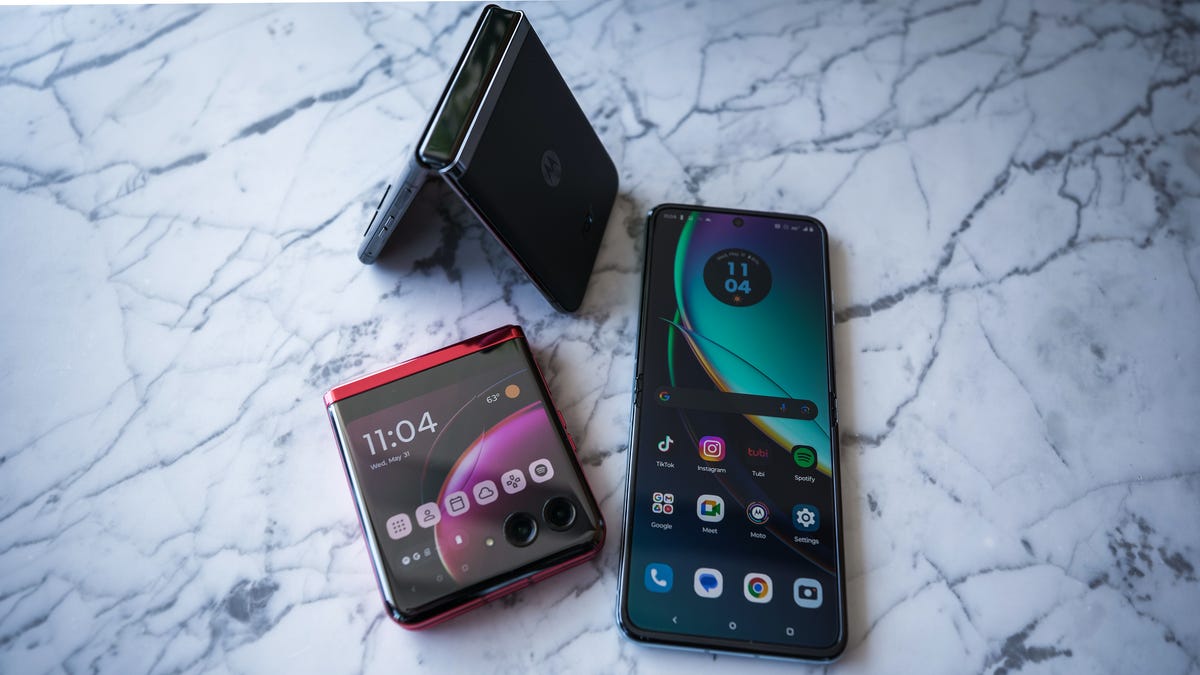
From Samsung to Motorola and Google, just about every major Android phone maker has released a foldable phone. But there’s one big, non-Android outlier: Apple. And according to Motorola, that’s prompting some iPhone users to make the switch.
Specifically, Motorola has seen 20% of new Razr users coming from Apple products. That data point is from 2021 following the launch of the previous-generation Razr.
“This is definitely the family that we have the most amount of iPhone users switching to us,” Allison Yi, Motorola’s head of North America product operations, said to CNET ahead of the company’s Razr Plus launch.
Foldable phones still account for a fragment of the global smartphone market, but the category is growing quickly as tech giants search for the next major evolution of the mobile phone. Market research firm International Data Corporation estimates that worldwide shipments of foldables will increase more than 50% in 2023 compared to 2022. Motorola’s Razr line faces the most competition from Samsung’s Galaxy Z Flip series, although Samsung hasn’t broken out its sales numbers to specify its percentage of iPhone converts.
This year is shaping up to be a milestone moment for foldables with the arrival of newcomers including Google and OnePlus, giving Motorola and other early entrants like Samsung more competition. Apple, however, is still noticeably absent from the foldable phone race, and that isn’t likely to change anytime too soon.
Apple hasn’t launched a foldable iPhone, nor has it announced any plans to do so. But these renders by YouTuber ConceptsiPhone imagines what a foldable iPhone could look like.
Ming-Chi Kuo, an analyst with TF International Securities known for his Apple product predictions, tweeted in April 2022 that he doesn’t expect Apple to release its first foldable gadget until 2025. A study from Counterpoint Research suggests there’s certainly demand for a foldable iPhone, at least in the US. Among the respondents, 39% named Apple as their preferred brand for a foldable phone, while 46% named Samsung — one of the earliest and most dominant players in foldable phones. Only 6% said Motorola.
The new Razr Plus and 2023 Razr are the company’s latest attempts to change that. The $1,000 Razr Plus, announced on Thursday and launching on June 23, has a giant cover screen that the company is betting will set it apart from rivals like the Galaxy Z Flip 4. Motorola is also launching a cheaper version of the Razr later this year for an undisclosed price that will be less expensive than the Plus model.
But whether it’s competition from Samsung or eventually the long-rumored iPhone Flip, Motorola isn’t fixated on its rivals.
“It’s not about what our competition is doing,” Yi said. “It’s more of what the consumer needs are, what consumers are wanting, rather than really focusing on competition.”
The Motorola Razr Plus
As first-timers like Google are just getting into foldable phones in 2023, companies like Motorola and Samsung are already brainstorming what could be next. Both companies earlier this year showcased concept devices with rollable or slidable screens that can expand as needed earlier. Motorola’s take involves a smartphone-sized device that can unroll to extend its display with the press of a button. It’s still a concept, and Motorola hasn’t said when or if this rollable phone will graduate to becoming a real product.
But Jeff Snow, Motorola’s product manager for premium and flagship devices, said he could eventually see it becoming an “offshoot” of the Razr we know today. While both the Razr and the rollable concept aim to make phones more portable, they execute that goal through different means. The Razr’s clamshell shape enables it to fold shut, function as a regular phone when opened or serve as something in between when propped open halfway. The rollable concept changes its shape in a different way by expanding and contracting its screen.
“It’s a little bit of a different experience,” said Snow. “But we see it becoming part of the same category.”
Motorola’s rollable phone concept
Motorola is also evaluating larger book-style foldables like the Galaxy Z Fold, although Yi said she couldn’t comment on future products. Snow also said there’s “merit to that form factor,” but the company would have to make sure it’s not compromising the regular phone experience while also providing improved productivity and content consumption.
“That space is taking off,” he said. “It’s something we’ll pay attention to.”
For now, the Razr Plus is Motorola’s biggest attempt at standing out in a crowded market, especially as Samsung and Apple continue to command the global smartphone market. The combination of technology improving and broader awareness around foldables makes now the right time for a new Razr, according to Yi.
“Sometimes you see the technology is ready, but the market is not ready to accept it,” she said. “And consumers are not willing to adapt or adopt. But in this case, we really feel that this is the right time.”
